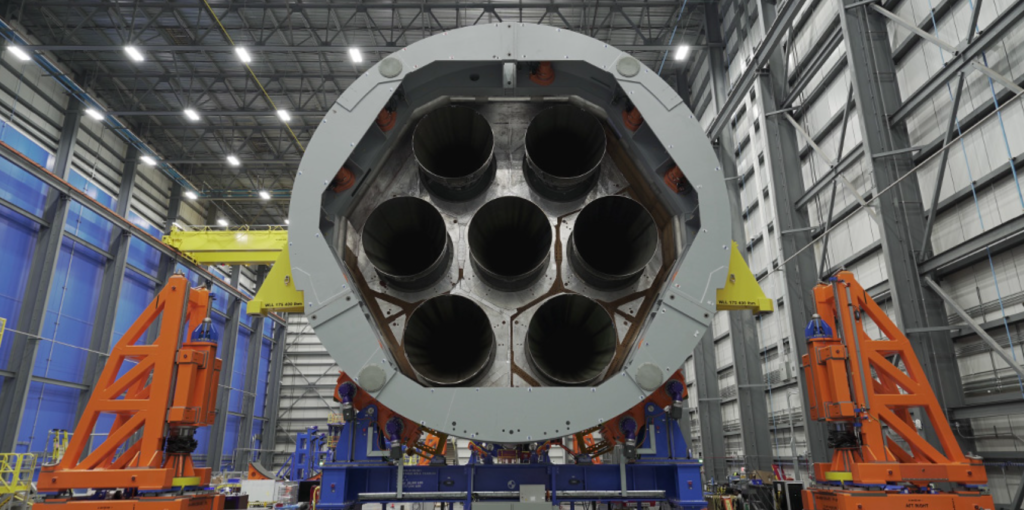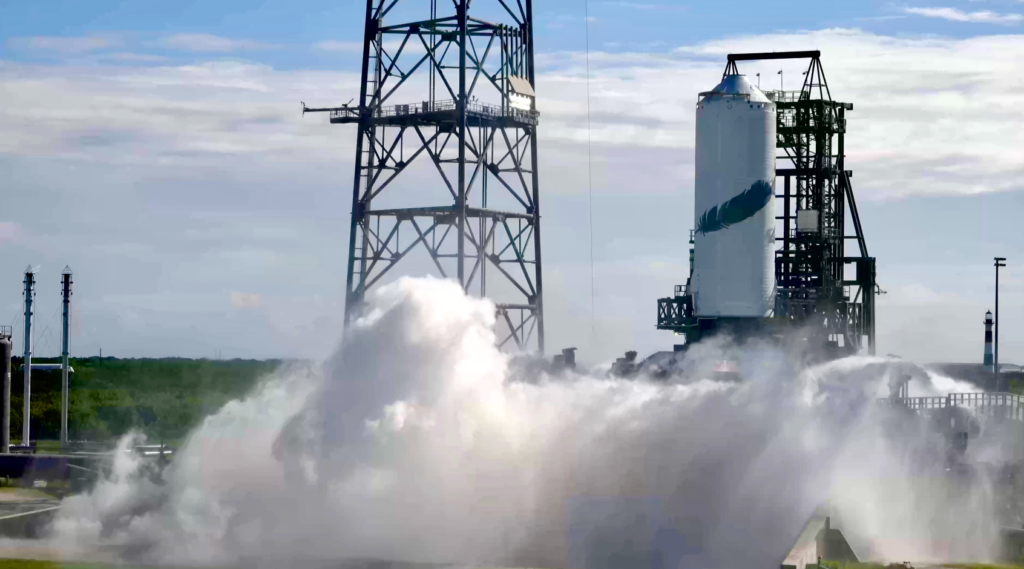Early this morning Blue Origin shared the first images of a New Glenn booster with 7 BE-4 engines installed. This is the first time we’ve ever seen this and with it all being flight hardware, a launch very soon is expected.
In addition to the image, the company’s CEO shared more information on the engines, their operation on the upcoming flight, and even which specific engines are responsible for gimbaling.
7 Engines Installed

This morning Blue Origin tweeted saying, “Seven BE-4s Check. New Glenn engine installation is complete!” This included an image of the bottom of the New Glenn stage and the 7 engine nozzles. They also shared a similar image but this time taken further away and with humans nearby which help give an idea of the scale of this rocket and the engines.
In response to the milestone, Blue Origin CEO Dave Limp was quoted saying, “Great job by the engineering, operations and engine teams on the installation. The seven BE-4 engines in this image will deliver more than 3.8 million pounds of thrust for New Glenn. Three of the seven engines gimbal to provide the control authority for New Glenn during ascent, re-entry, and landing on Jacklyn, our recovery vessel downrange at sea. That gimbal capability, along with the landing gear and Reaction Control System thrusters, are key to making our booster fully reusable. Fun fact: The vehicle’s max design gimbal condition is during ascent when it has to fight high-altitude winds” he said.
When he mentions 3 engines gimball, in the picture provided he’s referring to the center engine and one at 3 o’clock and 9 o’clock. In other words, they form a straight line horizontally in the image of the engines. Also as he mentioned, this will be used both during ascent but also for the landing burn and controlling the descent onto the landing vessel.
With the engines now installed, the booster for the first flight of New Glenn is practically ready for final testing and then a launch. Last month Blue Origin shared another image of the stage but this time from the side. Here you could see basically everything was done with the strakes installed, the fins, and even the landing legs.
As far as the brown non-painted regions, last month they clarified that they are just gonna keep the stage like that. Specifically, Dave Limp said, Some of you recently asked additional questions about Comet, the thermal protection system we created for New Glenn, and whether we’ll paint it on our vehicle.”
“We could—but have chosen not to for a variety of reasons, including adding unnecessary weight. It has been applied on our fins, forward module, strakes, tank tunnel, and the aft section, including the legs. As for the color, you tell me: Copper? Gold? Brown? Given the the thermal environment, we expect the material will change colors on our booster as we fly multiple missions” he said.
As for a launch date, early last month NASA announced a change to the mission. Specifically on September 6th, they tweeted saying, “NASA’s ESCAPADE (Escape and Plasma Acceleration and Dynamics Explorers) mission is now targeting a launch in 2025. ESCAPADE’s two satellites will investigate how solar wind interacts with the magnetic environment of Mars.
This mission was originally set to happen sometime this month and be New Glenn’s maiden flight. In response, Blue Origin tweeted saying, “We’re supportive of NASA’s decision to target the ESCAPADE mission for no earlier than spring 2025 and look forward to the flight. We plan to move up New Glenn’s second flight, originally scheduled for December, into November. New Glenn will carry Blue Ring technology and mark our first National Security Space Launch certification flight. We’ll provide more details on these launch plans in the coming weeks.
With this in mind, we should start to see testing very soon. In order to launch the rocket in November testing will have to begin just about right away and provide good results. Any anomaly or mishap would likely push the maiden flight into early next year. That being said, it seems that Blue Origin usually releases these updates days or even a couple of weeks after the event occurred. If that’s the case, it could mean these engines have been installed for a while and a booster static fire is right around the corner. Something to look out for in the coming weeks.
Even More Progress

While the booster getting its 7 BE-4 engines installed is a big deal, the upper stage is already way ahead. Last month Blue Origin completed a static fire of the upper-stage flight hardware.
In an official statement released after the test, they said, “New Glenn’s second stage (GS2) successfully completed a risk reduction hotfire test today, a milestone on our road to first flight, scheduled for launch in November, from Launch Complex 36 in Cape Canaveral, FL. NG-1 will carry Blue Ring technology as its first manifested payload.”
“The hotfire lasted 15 seconds and marked the first time we operated the vehicle as an integrated system. The purpose of the hotfire test was to validate interactions between the subsystems on the second stage, its two BE-3U engines, and the ground control systems.”
“Additionally, we demonstrated its three key systems, including: the tank pressurization control system, which uses helium to pressurize the liquid hydrogen and liquid oxygen tanks during flight; the thrust vector control system, which gimbals the engines and steers the rocket during flight; and validated the start-up and shut-down sequences for the BE-3U systems, which can be restarted up to three times during a mission” they said.
On launch day, while a lot of the focus will be on the booster and whether or not it successfully launches and then lands on a ship out at sea, the main goal is still to deploy the Blue Ring payload.
They finish by saying, “In addition to testing our flight hardware, this hotfire test was also an opportunity for the launch operations team to practice launch day procedures on console and verify timing for a number of critical operations.”
Even though this will be the first time BE-4 engines fire on a New Glenn booster, they actually have some flight experience already. Vulcan has now flown two times and the two BE-4 engines have performed very well in both occasions. This supports a clean test campaign and a launch possibly in November.
As partially mentioned before, by now it’s confirmed that they will be trying to land the booster on the first try. Last month they shared a different image of the booster showcasing its name “So You’re Telling Me There’s a Chance.”
Dave Limp commented, “We have a cool history naming key Blue hardware that dates back to New Shepard. We’re calling New Glenn’s first booster “So You’re Telling Me There’s a Chance.” Why? No one has landed a reusable booster on the first try. Yet, we’re going for it, and humbly submit having good confidence in landing it. But like I said a couple of weeks ago, if we don’t, we’ll learn and keep trying until we do” he said.
Based on these comments, it’s clear Blue Origin has some confidence going into the first flight and landing attempt. They do have some experience with New Shepard but even still there are some major differences this time around. For one the booster is significantly larger. Standing at around 57m tall and 7m wide, there’s a lot more rocket that needs to land. You then have the first use of BE-4 engines on New Glenn which will need to throttle and perform perfectly.
A big part of the design of the BE-4 engines has engine reuse in mind. The company points out that “BE-4 was designed from the beginning to be a medium-performing version of a high-performance architecture. It’s a conscious design choice made to lower development risk while attempting to meet performance, schedule and reusability requirements. With our hardware-rich approach, multiple developmental units and redundant test stands enable a high test tempo and rapid learning” they said.
For the propellant, they chose LNG because it’s highly efficient, low cost and widely available. They mention that “Unlike kerosene, LNG can be used to self-pressurize its tank. Known as autogenous repressurization, this eliminates the need for costly and complex systems that draw on Earth’s scarce helium reserves. LNG also possesses clean combustion characteristics even at low throttle, simplifying engine reuse compared to kerosene fuels” they said.
It’s been a long time coming, but Blue Origin is close to launching New Glenn. The new Blue Ring payload is also important to the company. Just about a year ago Blue Origin unveiled Blue Ring, which is a spacecraft platform focused on providing in-space logistics and delivery. In an official statement, they said, “Blue Ring serves commercial and government customers and can support a variety of missions in medium Earth orbit out to the cislunar region and beyond. The platform provides end-to-end services that span hosting, transportation, refueling, data relay, and logistics, including an “in-space” cloud computing capability. Blue Ring can host payloads of more than 3,000 kg and provides unprecedented delta-V capabilities and mission flexibility” they pointed out.
Over the next few weeks, we should expect quite a bit of progress as Blue Origin completes some of the final pre-launch tests and activities. If everything goes well, it’s possible we see a maiden flight as soon as next month in November.
Conclusion
New Glenn’s first stage is now basically complete with its 7 BE-4 engines installed. With the second stage already successfully completing a static fire last month, one of the next steps will be a booster static fire, and not long after a launch.

Hello.
Good cheer to all on this beautiful day!!!!!
Good luck 🙂